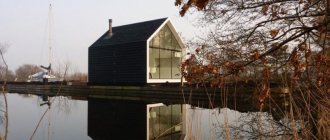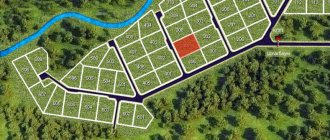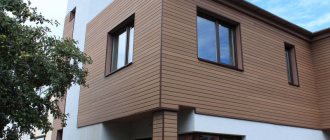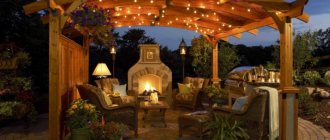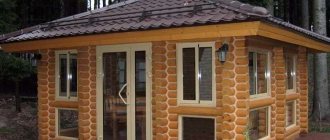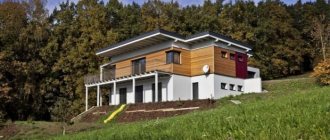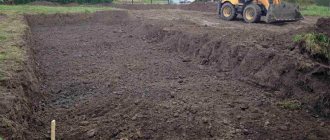- Plot with a slope origin and features
- Advantages and disadvantages
- What to pay attention to
- Features of choosing a plan depending on the steepness of the slope
- Foundation structure
- Additional work
- The preparation stage and everything that goes into it
- Start of construction
- Terracing a house
- Arrangement
- Designing a country cottage on a slope: design nuances
- Conclusion and tips
Noise, bustle, polluted air are just some of the disadvantages of living in big cities. To avoid all this, many people seek to sell their apartments and move to live outside the city. Most often this happens when planning to have children. Trying to protect them from the negative influence of the environment, parents move closer to nature. But it’s not always possible to find a perfectly flat place. Therefore, today projects of modern houses on a slope are quite popular.
Plot with a slope origin and features
Potential homeowners are often afraid to make a choice in favor of such an architectural solution. Many believe that the location greatly increases the cost of construction, and also significantly reduces the service life of the building. But these are just myths.
In fact, erecting buildings on uneven areas is not difficult. Having modern equipment at their disposal and having a sufficient amount of knowledge, construction companies will quickly and efficiently install a one-story or two-story house on a slope of any complexity. In some cases, it may even cost less than building on completely flat land.
So, there are several degrees of slope:
- small – up to 8%.
- average – up to 20%.
- steep – above 20%.
Measuring this indicator is quite simple: walk 100 meters up the site and measure how high you rise. For example, if you climbed 15 meters, then it will be equal to 15%.
Before you begin construction, you should determine the type of slope and the history of its origin. The procedure is very important, since many nuances that will be taken into account during the design depend on its result. So, slopes are divided into 3 types:
- Ravine. A depression that was formed as a result of the influence of rain, groundwater and melt water on the soil. These formations mainly occur in areas with fairly loose soils, as well as in places where vegetation is poorly developed.
- Natural decline. This type includes mountain cliffs and coastal areas. They are perfect for small private construction, as they have fairly stable soils.
- Slope formed by anthropogenic means. Most often they occur in places where mining occurs: failures in mines and quarries. Such areas are extremely unstable, which must be taken into account at all stages of building construction.
House on a sloped plot: pros and cons
You have a plot of land for construction that is not level. What to do if the angle is rather large, but there is no idea how to deal with it. There is a simple recipe in such cases - use all the disadvantages as advantages. Reviewing the implemented solutions of designers and current designs of houses on a plot with a slope will help you change your attitude towards this issue.
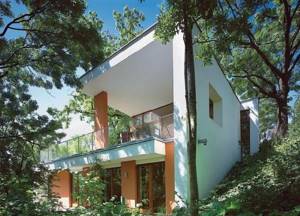
Having analyzed all the negative and positive aspects of building such a house, we can name the following positive aspects:
- a slight slope will allow you to create a system of terraces, which in turn will organize a high-quality layout of the cottage’s courtyard and will allow you to apply the best practices in landscape design;
- a house on a plot with a slope can be located on several levels, without the cost of building a lower floor or with minimal costs;
- a slope of up to 8% will allow the lower floor to be allocated for household needs; this part of the house can be used for a garage. Thus, part of the territory is freed up, which would be used less rationally on flat terrain;
- The terrace layout and multi-storey building look very impressive and will add uniqueness to your home.
There is also an important economic component - the price of land on a slope is traditionally lower than the price of a flat site for construction.

There are also some negative aspects to this type of construction:
- due to the close proximity to large masses of earth and the possible flow of upper groundwater through the structure of the house, enhanced waterproofing of the foundation, and sometimes parts of the walls, is required, their strengthening;
- construction on several levels will require additional costs for materials for terraces, steps, fences, and other elements of the house;
- the development of an individual project is required, since a standard project is unlikely to be suitable in this case, since there may be too many features on such a site;
- laying communications will be more complex and may require the installation of additional equipment, including pumps and other devices.
Advantages and disadvantages
Today, there are more advantages than disadvantages to buildings on uneven sites. The first include the following:
- Uniqueness of architecture. Take a look at these houses. They look much more impressive. This impression arises due to the variety of columns, stairs and steps.
- Possibility of building an additional ground floor.
- Saving on communications. In particular, this applies to sewage drains. In conventional design, for better sewage drainage, experts recommend installing additional pumps. And their purchase and maintenance are additional expenses. Here, the outflow of dirty liquid will occur naturally, in accordance with the laws of physics.
- There is no need for a drainage system. Rain and melt water will flow down by gravity.

But there are also disadvantages that can scare away potential clients from purchasing such plots. These include:
- The need to strengthen the soil. Even if there is very stable soil on the slope, there is a possibility of landslides. That is why experts recommend not skimping on special strengthening measures.
- Impressive costs in the first stages of construction. Sometimes making a pit and installing a foundation costs people more than all other work.
- Formation of cold pockets. Cold air sinks down under its own weight. Your possession gets in his way. That is why it is recommended to erect buildings at the maximum accessible height.
- Costs of waterproofing systems. A certain part of the foundation of such a house will be deeply buried in the ground. In this place you need to pay special attention to waterproofing.
What to pay attention to
Before you finally decide on the location of future construction, be sure to carefully study the site and pay attention to the following:
- The steepness of the slope. The slope is the main indicator on which the complexity and, accordingly, the volume of cash injections from the customer will depend.
- The orientation or placement of a house relative to the cardinal directions. For most regions of our country, this is the southeast. In this case, the maximum amount of sunlight will penetrate into your home. But there is an exception. Thus, in the southern regions it is recommended to build their properties on the north side. This allows you to minimize the heating of the building during the daytime.
- Possibility of constructing access roads. This indicator is very important not only for the delivery of construction equipment to the site, but also for the further operation of the building.
- Possibility of supplying communications and arranging outbuildings. When building on difficult terrain, problems with drinking water supply may arise. It is also important to immediately, before starting work, calculate where and how the bathhouse, garage, playground, and so on will be built.
Features of choosing a plan depending on the steepness of the slope

When making decisions, experts are guided by a very large number of different parameters and indicators. But the most basic of them is the slope level:
- Quite small. This means that the area is very flat. In this case, builders erect standard buildings. However, they advise adding a little soil. This will allow you to implement a project for a beautiful house on a slope with an amazing terrace (you can see the photo below).
- Average. In this case, the construction of standard buildings is also allowed. The only limitation is the lack of a basement (basement, underground garage, etc.).
- Above average. Here, experts recommend placing cottages with basement floors after first removing some soil. Similar options require significant investments in the installation of waterproofing systems. Access roads to such buildings are usually laid to the lower part. This allows you to organize a garage on the ground floors.
- High. Construction on such sites requires an individual approach. Typically, platforms are turned into several tiers, each of which is reinforced with a special wall for better fixation.
General information
Advantages and disadvantages
Plots on an elephant with a terrace are preferred only by those people who are accustomed to non-standard solutions. This is due to the fact that arrangement will require a creative approach.
In favor of choosing construction on such a site, we present the following facts:
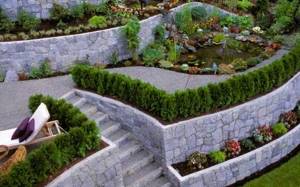
Good yield.- Unique appearance.
- Ease of construction of certain elements.
- It is possible to view the entire territory.
- You can create true works of art.
Thanks to the presence of a slope, your building will be pulled out of the gray mass and will stand out with its unique design, and this will be a pleasant difference from cottages of the same type. Two adjacent dachas on a slope will not be similar to each other due to differences in relief. Thanks to the slope on the site, you can even make your own little Paradise that will delight your soul and eye. In addition, it will be possible to create interesting elements on the site, which, if built on a regular horizontal plane, would require large expenses.
These types of elements include an artificial waterfall, for which it will be enough to lay out a gutter made of stone. The same applies to the alpine slide. If you were the owner of a horizontal plot, to construct such a plan you would have to bring additional material to the plot. Ideal if the slope is in the south. In this case, the yield will be many times higher, since the area on the slope will warm up under the sun for most of the day.
But there are still some disadvantages that it would be fair to mention:
- Difficulties when planting a lawn.
- Danger for small children.
- Additional expenses for arrangement.
- More effort to move around the area.
- You will have to water the plants frequently.
- There are unstable areas.
- You will need to place the house at the very top of the slope.
In principle, planting a lawn on a slope is quite possible, but caring for such an area will be more difficult than under standard conditions. For these purposes, it is best to use a self-propelled lawn mower, which you will not need to drag behind you. But remember that the arrangement will result in additional expenses for you, but in order to avoid a blow to the budget, you can carry out the arrangement gradually.
From a summer cottage on a slope with a terrace, water will drain faster, and therefore the plants will need to be watered more often than required. You can choose to plant plants and shrubs that do not require a lot of moisture. Slopes can also be unstable, and for this reason builders advise placing buildings on the top to avoid raising the foundation.
It is also worth remembering that moving around an area with uneven terrain requires some effort, but it will help you feel better (though this is still a disadvantage for older people). It is important that children are supervised at all times to avoid injury when playing on slopes.
Foundation structure
This is the main part of any building. The durability and viability of the entire future structure depends on the correct installation. After all, even if you build walls from the strongest and highest quality materials, but save on the foundation, the building will not last even a year. Experts recommend using the following types of foundations when implementing a project for a beautiful house on a steep mountain slope:
- Monolithic - occurs most often. It is recommended for use in areas with stable soil types. The only problem during installation is access roads for heavy equipment.
- Stepped. The main difference from the previous one is its thickness depending on the slope of the surface.
- Pile, screw. One of the most reliable ways to construct a building. This foundation is used on both stable and very unstable soils. Its peculiarity is that the piles are twisted into the ground to a great depth (up to 20 meters) and reach the dense layers of the earth’s crust. The only negative is the lack of possibility of arranging ground floors and basements.
Placing the foundation on a slope
The size of the slope affects both the architecture of the house in general and the design of the foundation in particular. It is calculated by determining the difference in height between two points on the ground and dividing it by the distance between them.
What are the options
If the slope is small (up to 7%), then the house can be placed on a flat area, for which the soil is cut off a little on one side and added to the other, as shown in the photo below. This is the only case when there is no need to order an individual project, but you can use a standard project.
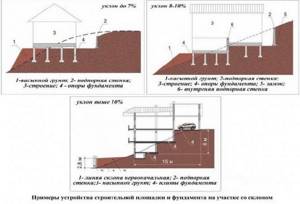
Options for slopes and placement of houses on them
In the second option, with more significant slopes (from 8 to 10%), the basement floor of the house on the slope crashes into the ground. At the same time, on the one hand it will be completely buried, and on the other hand, the deepening will be insignificant, or there will be none at all. This can be clearly seen in the picture below.

The difference in foundation depth is obvious
The construction of a house on a steep slope (more than 10%) assumes a stepped structure, in which the building will have several levels, each of which is shifted in the direction of the slope. This is the most technically complex option, and also the most costly. It, as in the case of buildings on a moderate slope, must be designed individually.
In the latter case, the main entrance to the building, and even the garage, can be located both in the lower part of the house and in the upper part. This already depends on the development of the slope as a whole, the location of the streets and neighboring houses.
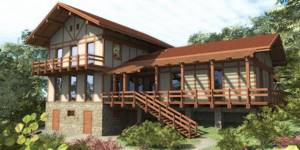
Ground floor on a slope: project for individual use
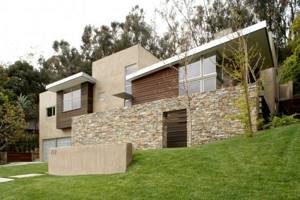
House on a hill with a slight slope

Basement floor foundation with windows: multi-stage site layout

Garage on the top level of the building
Additional work
As mentioned above, planning to build on hillsides and slopes requires serious work. You have to do:
- Installation of drainage system. We said earlier that the construction of houses on uneven plots guarantees their owners the natural outflow of groundwater, melt and rainwater, and therefore there is no need for drainage. This is true. But there is a possibility that humidity can negatively affect the durability of the entire structure. Therefore, to be on the safe side, builders recommend installing such structures in the form of dug grooves, which are later covered with rubble.
- Installation of blind area. Even if you built a cottage on very compact soil, there may still be slight movements. Therefore, a special barrier made of reinforced mesh and concrete should be erected around the perimeter of the entire building.
The preparation stage and everything that goes into it

After you have decided on the construction site, the preparatory stage begins. During this process, you need to take several important steps, namely:
- Carry out engineering and geological work. These include determining the type of soil and the depth of groundwater. The type of foundation that will be used during construction, as well as the need to install various drainage structures, will depend on these two indicators.
- When you looked at photographs of projects of houses with a terrace on steep slopes, you may have noticed that they depict not only the cottages themselves, but also all communications, as well as access roads. This is another important step that must be taken before starting the main work - creating an extended construction plan.
- It is necessary to cut off the top layer of soil. The feasibility of the procedure is determined at the design stage. It looks like this: using special heavy equipment, the site is leveled. Excess soil is transported off-site. In this case, there is a disturbance in the occurrence of soils and a change in the movement of groundwater. And this can lead to additional costs for strengthening the slope.
Start of construction
The construction of such a cottage is somewhat different from similar work on level ground. In addition to the standard clearing of the earth's surface from debris and anything unnecessary, it is necessary to perform the following actions:
- Creation of drainage. This is a small ditch that is made around the perimeter of the entire construction site.
- Gain. The action is intended to prevent landslides and protect the future foundation from various types of deformations.
- Reinforcement. A special procedure during which geogrids are installed - structures that resemble a honeycomb in appearance.
Terracing a house
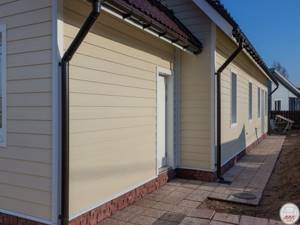
One of the main advantages is the possibility of arranging terraces. At first glance, this may seem like a time-consuming and unnecessary process, but in the end you will get a wonderful territory, decorated with various cascading drops. Photos of such houses on a slope are presented in our article.
There are several types of designs:
- Comb. For its manufacture, a slope of 3 to 11 centimeters is required. It is erected by installing it across the ridge, about 40 centimeters high. These sites are usually used for growing grapes.
- Stepped. The ideal slope for such a terrace is approximately 13 centimeters. For greater stability, similar structures are usually covered with stone or decorative brick.
- Ditches. For such terracing, soil is taken from drainage channels and poured into shafts, the height of which must be at least 3 meters.
Arrangement
A huge advantage of two-level house projects on a plot with a slope is that many design solutions can be applied when constructing them. These include:
- Various steps and ladders.
- Closed and open drainage systems.
- Waterfalls.
- Retaining walls (concrete, stone, brick, wood).
- Various options for strengthening the soil (using plants, geomaterials, etc.).
Land on a slope - what can be done
A detailed study of many nuances and a thoughtful approach allow us to obtain original solutions. Defects that are incorrigible at first glance turn into a highlight, as a result of which a summer cottage site located on a slope acquires attractive advantages that arouse the admiration of neighbors.
To ensure that the efforts expended are not wasted, before starting work it is advisable to study the area from the point of view of its further planning. Particular attention should be paid to functionality.

Interesting design of a cottage on a slope
The buildings built into the slope look very original. Such tactics expand the range of architectural solutions by implementing additional exits to the adjacent territory from different levels.
At the planning stage, it is advisable to decide on the locations:
- outbuildings, the operation of which requires the supply of electricity;
- gas or water pipes (toilet, summer kitchen, bathhouse).
Preliminary marking of areas for:
- flower beds;
- lawn at the dacha;
- gazebos;
- canopy;
- recreation areas.
The slope can also be used to arrange a cellar.

In the photo - making retaining walls
A careful study of level differences and protrusions can prompt a non-standard solution in the field of landscape design.
Some corners seem to be created by nature for:
- waterfalls;
- streams;
- light openwork country bridges.
Rocky areas are ideal for creating rock gardens that recreate a mountain landscape.
Coping with steep slopes
The predominant part of summer cottages is used for planting trees, ornamental and agricultural plants.
Realization of the set goals is impossible without reducing the steepness of the slope.
- To solve this problem, they most often resort to such a simple method of transforming the relief as terracing.
- When developing a terrace plan, it is important to work out how to connect individual areas.
- Level paths or stairs can be used as the latter.
- Climbing and descending steep steps can lead to fatigue. As a result, it is highly desirable that the height difference between elements does not exceed 10 cm.
- Staircases designed for heavy loads should be wide.
Advice: during construction, give preference to monolithic structures erected using the formwork method from a concrete mixture.
- Decoration with stones and tiles begins after the main work is completed.
Tip: For the construction of small stairs, use wood and natural stones, fixed with cement mortar or dry-laid.
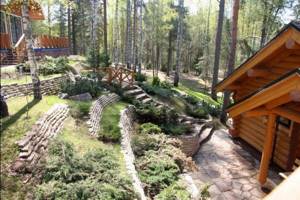
What does a dacha plot on a slope with artificial terraces look like?
The transformation of the landscape begins after drawing up a site plan. A sketch created on the ground will also come in handy. Steeper slopes require more terraces.
Advice: when arranging the latter, you should not forget about the level of difference. The value of this indicator should tend to a minimum.
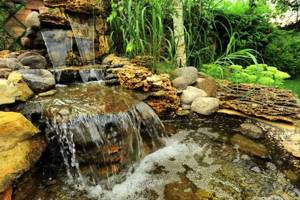
Landscape design - waterfall on the site
| Preparatory stage | Before starting work, it is necessary to calculate the height of the walls supporting the terrace and determine the volume of soil to be moved. If the mass of the soil poured and removed during the work is equal, there is no need to transport it. |
| Territory marking |
This tactic ensures the preservation of the fertile layer. The freed space is used to form a terrace ledge. |
Support structures
To enhance the stability of the terraces being built, supporting walls are used, the main function of which is to hold the soil and redistribute the pressure it exerts. Let's look at different materials:
| Wood |
|
| Stone | People became convinced of the practicality of supporting walls made of stone several centuries ago. The basis of the method, which does not require a solution, was the selection of stones of appropriate shapes and sizes. Implementing this method in practice requires creative thinking and perseverance. The price of work depends on the volume. |
| Concrete | Individuals who are far from construction can resort to the method of pouring monolithic concrete. The arrangement of supporting walls made of natural stone, fixed with mortar, also does not require special knowledge. |
| Blocks and bricks | The instructions allow the construction of supporting walls from such materials. Before installation begins, work related to the creation of a monolithic foundation must be completed. Most often, the tape variety is used for these purposes, which attracts owners with its high degree of reliability. With its help, high terraces are built, which are characterized by large differences. |
Strengthening slopes in a summer cottage with stones and concrete
Excess moisture problem
Effective functioning of supporting walls is impossible without a drainage system. Excess moisture is successfully combated by a drainage layer, for the construction of which sand and crushed stone are used.
They cope with the task:
- drainage pipes laid towards the slope of the terraces (1 pipe is laid for every 2.5 m);
- if required, drainage trays can be used.
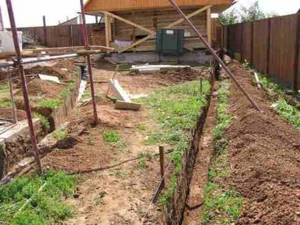
Territory drainage
Backfilling of the terrace is carried out in the following order:
- the drainage layer is covered with an infertile layer of soil;
- Vegetable soil follows on top.
Remember, the possibility of ground settlement cannot be ruled out. The occurrence of this complication is most likely during the first few days.
Advice: it is advisable to start work related to the improvement of the site after filling up the settled soil.
Designing a country cottage on a slope: design nuances
If you decide to build such a cottage, rest assured that you will definitely be able to stand out among your friends and acquaintances. After all, the layout of such a building requires an individual approach. As a result, you will get a unique structure.
But there are some similarities. They arise when creating a project and relate to the height difference of the future building. They are divided into 2 types:
- Buildings with stepped storeys. They consist of several levels, which are shifted relative to each other vertically. This creates the illusion that there are several sections in the room, when in fact the lower tier is a continuation of the upper one (or vice versa).
- Variable number of floors. The bottom line is this: the house is also divided into sections. But, unlike the previous one, the roofs of all modules are placed on the same level.
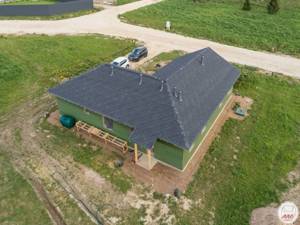
Also, to realize the uniqueness of the project, designers use different techniques. Among them:
- Arrangement of separate exits on each floor. Not only does it look very nice, but it is also quite practical, especially for elderly residents, as well as people with disabilities.
- Flat roof. This solution allows you to make good use of the upper platform. Often gazebos, barbecue areas, sports areas and even swimming pools are organized on it.
- Roof garden. Not everyone can afford such a decorative element, because it requires serious financial investments. Believe me, the cottages where we managed to implement the idea look simply amazing from the outside.
